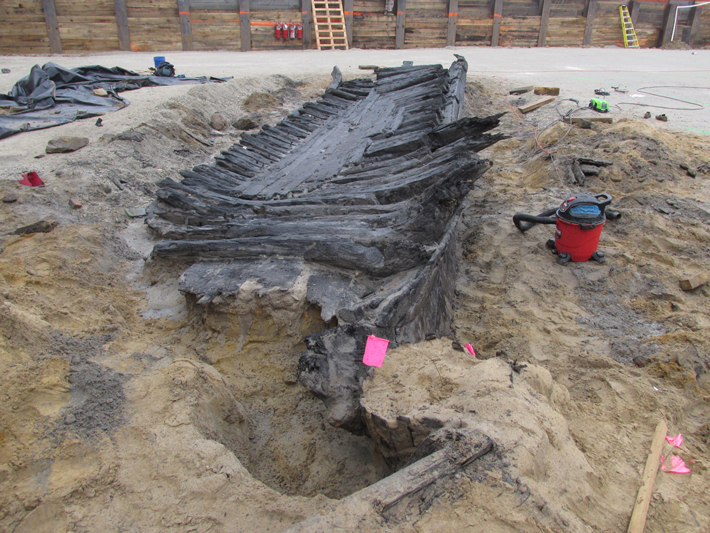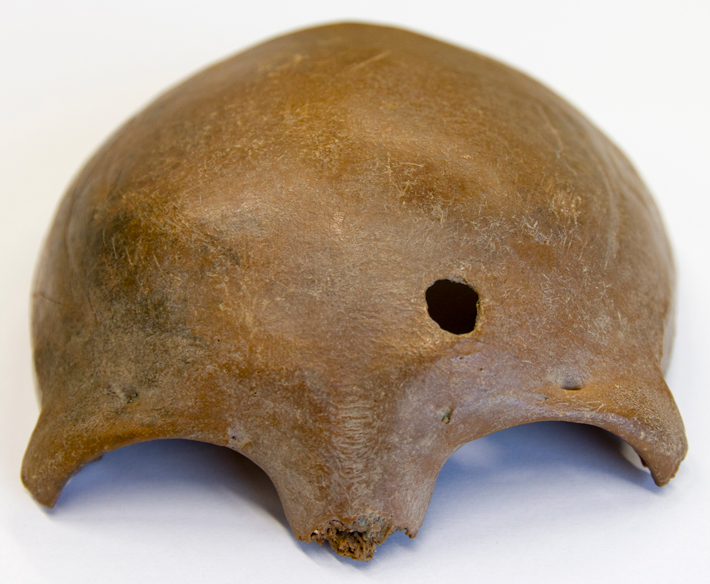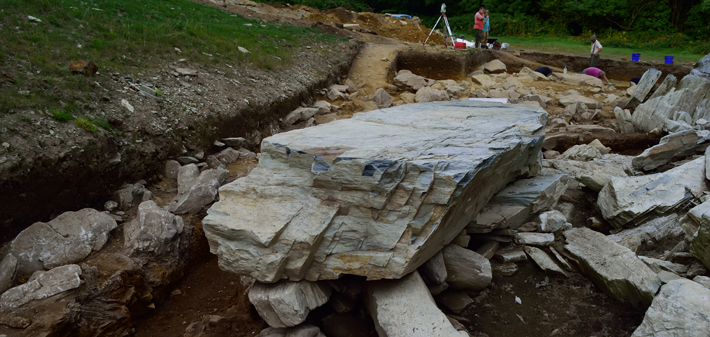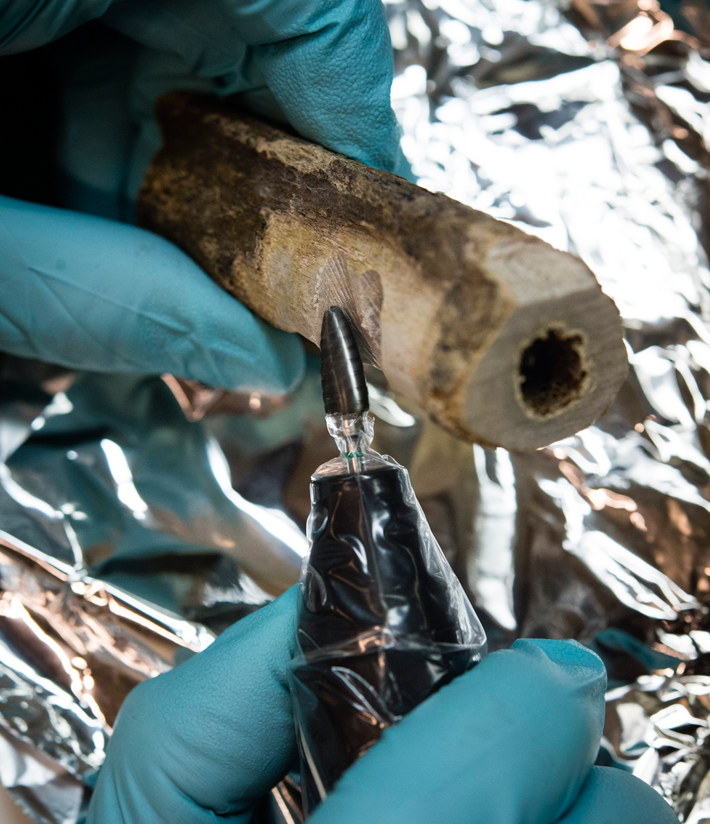From the Trenches
Ship Underground
By DANIEL WEISS
Tuesday, February 16, 2016
 A large portion of an eighteenth-century ship that measured around 80 feet long was recently discovered on the site of a planned hotel near the Potomac River in Alexandria, Virginia. The vessel appears to have been scuttled between 1775 and 1798 in what were then mud flats, where it served “as sort of a pre-built framework to hold soil that was being deposited to make new land,” says Boyd Sipe, manager of Thunderbird Archeology, the firm that conducted the survey. Based on its size and evidence that its hull timbers had contact with salt water, Sipe says the ship was most likely a two-masted oceangoing heavy cargo or military craft.
A large portion of an eighteenth-century ship that measured around 80 feet long was recently discovered on the site of a planned hotel near the Potomac River in Alexandria, Virginia. The vessel appears to have been scuttled between 1775 and 1798 in what were then mud flats, where it served “as sort of a pre-built framework to hold soil that was being deposited to make new land,” says Boyd Sipe, manager of Thunderbird Archeology, the firm that conducted the survey. Based on its size and evidence that its hull timbers had contact with salt water, Sipe says the ship was most likely a two-masted oceangoing heavy cargo or military craft.
The timbers were particularly well preserved because, once buried, they were sealed off from oxygen and were not disturbed despite extensive construction in the area in the nineteenth and twentieth centuries. At the site, archaeologists have also discovered the remains of Alexandria’s first public warehouse, dating to the 1750s, and three privies containing extensive artifacts including a complete kaolin pipe, jewelry, ceramics, glass bottles, and parts of leather shoes.
Caesar’s Diplomatic Breakdown
By JASON URBANUS
Tuesday, February 16, 2016
 Dutch archaeologists have examined archaeological, historical, and geochemical data to pinpoint the site of a catastrophic battle between Julius Caesar and two Germanic tribes, the Tencteri and Usipetes. According to the Commentarii de Bello Gallico, Caesar’s firsthand account of the campaign, the two tribes crossed the Rhine River in 55 B.C. and petitioned Caesar to allow them to settle in Gaul. After negotiations collapsed and the Germans attacked his cavalry, Caesar directed his entire army of eight legions against the German camp, killing 150,000 to 200,000 men, women, and children. The recent study analyzed a deposit of metal artifacts and human skeletal remains that was retrieved during dredging of the Meuse River near the village of Kessel in the Netherlands. The mass of first-century B.C. weaponry, including swords, spearheads, and helmets, as well as the condition and radiocarbon dates of the bones, seem to confirm the site of the slaughter. Some of the skeletal remains bear holes and other marks of violent trauma. Scholars believe that the Romans may have dumped the battlefield remnants in the river after the fight. Geochemical analysis of the dental enamel of three individuals also indicates that they were not native to the Dutch river area, confirming Caesar’s own account that the Tencteri and Usipetes had emigrated from somewhere east of the Rhine. “This research is important because it not only contributes to a better understanding of the military history of Caesar’s Germanic campaigns,” says Nico Roymans of VU University Amsterdam, “but it also informs us about the highly violent nature of the Roman conquest, including cases of genocide, and the dramatic impact it must have had on the indigenous societies in this frontier zone.”
Dutch archaeologists have examined archaeological, historical, and geochemical data to pinpoint the site of a catastrophic battle between Julius Caesar and two Germanic tribes, the Tencteri and Usipetes. According to the Commentarii de Bello Gallico, Caesar’s firsthand account of the campaign, the two tribes crossed the Rhine River in 55 B.C. and petitioned Caesar to allow them to settle in Gaul. After negotiations collapsed and the Germans attacked his cavalry, Caesar directed his entire army of eight legions against the German camp, killing 150,000 to 200,000 men, women, and children. The recent study analyzed a deposit of metal artifacts and human skeletal remains that was retrieved during dredging of the Meuse River near the village of Kessel in the Netherlands. The mass of first-century B.C. weaponry, including swords, spearheads, and helmets, as well as the condition and radiocarbon dates of the bones, seem to confirm the site of the slaughter. Some of the skeletal remains bear holes and other marks of violent trauma. Scholars believe that the Romans may have dumped the battlefield remnants in the river after the fight. Geochemical analysis of the dental enamel of three individuals also indicates that they were not native to the Dutch river area, confirming Caesar’s own account that the Tencteri and Usipetes had emigrated from somewhere east of the Rhine. “This research is important because it not only contributes to a better understanding of the military history of Caesar’s Germanic campaigns,” says Nico Roymans of VU University Amsterdam, “but it also informs us about the highly violent nature of the Roman conquest, including cases of genocide, and the dramatic impact it must have had on the indigenous societies in this frontier zone.”
Quarrying Stonehenge
By ERIC A. POWELL
Tuesday, February 16, 2016

A team of archaeologists and geologists excavating two ancient quarries in the Presili Hills of west Wales has confirmed that these sites are the sources of the 43 “bluestones” erected at Stonehenge. Weighing on average between one and two tons, these igneous and volcanic rocks were transported to Stonehenge sometime around 3000 B.C. But radiocarbon dating of charcoal discovered at quarry-related camps shows that Neolithic workers were active at the two sites some 300 to 500 years before the earliest installation of bluestones at Stonehenge. This suggests that the megaliths may have been quarried and erected in the immediate area long before they were transported to Stonehenge. “We suspect that there is a dismantled stone circle monument somewhere in the area between the quarries,” says University College London archaeologist Mike Parker Pearson, who led the team. “We expect to find it and excavate it in 2016.”
A Viral Fingerprint
By DANIEL WEISS
Tuesday, February 16, 2016
 Researchers have extracted and characterized viral DNA from decades-old human bones for the first time—and used it to help determine the surprising origins of several long-lost casualties of war. The bones, which belonged to 106 soldiers killed in World War II, were retrieved over the past two decades from the forests of Karelia, in present-day Russia. The researchers found DNA of parvovirus, a common childhood affliction, in the remains of nearly half the soldiers.
Researchers have extracted and characterized viral DNA from decades-old human bones for the first time—and used it to help determine the surprising origins of several long-lost casualties of war. The bones, which belonged to 106 soldiers killed in World War II, were retrieved over the past two decades from the forests of Karelia, in present-day Russia. The researchers found DNA of parvovirus, a common childhood affliction, in the remains of nearly half the soldiers.
The bones included in the study are thought to have all belonged to Finns, but the type of parvovirus found in the bones of two of the soldiers has never been known to occur in northern Europe. A closer look at these soldiers’ own genetic material revealed sequences that tend to be found in parts of Asia and areas to the south, suggesting that the soldiers were part of the Soviet Red Army. “This shows that viral genetic sequences—in addition to human genetic sequences—can be used as a geographical fingerprint,” says Klaus Hedman, a clinical virologist at the University of Helsinki, “providing a means of identifying people’s origins.”
Minding the Beeswax
By ZACH ZORICH
Tuesday, February 16, 2016
 Recent results from a long-term study of pottery residues has revealed that farmers in the Middle East and Europe had been using beeswax for almost as long as they had made pots—but perhaps just not extensively. The discovery was made possible because of advances in techniques for distinguishing different types of lipids, naturally occurring molecules such as fats and waxes, from each other. Of thousands of sherds studied, about 80 were found to contain beeswax, indicating that it may have been a relatively scarce material in the Neolithic period, the time when people were starting to farm and make pottery.
Recent results from a long-term study of pottery residues has revealed that farmers in the Middle East and Europe had been using beeswax for almost as long as they had made pots—but perhaps just not extensively. The discovery was made possible because of advances in techniques for distinguishing different types of lipids, naturally occurring molecules such as fats and waxes, from each other. Of thousands of sherds studied, about 80 were found to contain beeswax, indicating that it may have been a relatively scarce material in the Neolithic period, the time when people were starting to farm and make pottery.
What Neolithic people were doing with the beeswax is a matter of speculation. According to Melanie Roffet-Salque, a biochemist at the University of Bristol and leader of the research group, it may have been used to waterproof the inside of pots, or may have been deposited as wax combs were melted to extract valuable honey—one of the few sweeteners available at the time. The earliest pottery sherds containing beeswax date to the seventh millennium B.C., and were found at several sites in what is now Turkey. One of these, Cayönü Tepesi, is also where the research team previously found a pottery sherd that contains the earliest evidence of milk use.
Roffet-Salque also cautions that the presence of beeswax residue on pots does not necessarily mean that early farmers were beekeepers. They may have been harvesting wild honey and wax. The first solid evidence of beekeeping appears in an Egyptian painting from 2400 B.C., but bee products clearly have a much longer history. A lump of beeswax found among other artifacts in South Africa’s Border Cave is at least 24,000 years old.
Studying pottery using this process has produced important findings about what products Neolithic people used or valued, but it has at least one drawback. “It’s very time-consuming,” says Roffet-Salque. “It’s taken us 20 years for 6,000 sherds.”
Advertisement
Advertisement
IN THIS ISSUE
Features
Öland, Sweden. Spring, A.D. 480
France’s Roman Heritage
Recovering Hidden Texts
Letter from Guatemala
From the Trenches
Legends of Glastonbury Abbey
Off the Grid
A Circle of Skulls
Medieval Russian Memo
The Ring’s the Thing
Chinatown before the Quake
Tomb from a Lost Tribe
Alfred the Great’s Forgotten Ally
Reading an Inca Archive
Minding the Beeswax
Quarrying Stonehenge
A Viral Fingerprint
Caesar’s Diplomatic Breakdown
Ship Underground
Advertisement

Recent Issues
-
 May/June 2024
May/June 2024
-
 March/April 2024
March/April 2024
-
 January/February 2024
January/February 2024
-
 November/December 2023
November/December 2023
-
 September/October 2023
September/October 2023
-
 July/August 2023
July/August 2023
-
 May/June 2023
May/June 2023
-
 March/April 2023
March/April 2023
-
 January/February 2023
January/February 2023
-
 November/December 2022
November/December 2022
-
 September/October 2022
September/October 2022
-
 July/August 2022
July/August 2022
-
 May/June 2022
May/June 2022
-
 March/April 2022
March/April 2022
-
 January/February 2022
January/February 2022
-
 November/December 2021
November/December 2021
-
 September/October 2021
September/October 2021
-
 July/August 2021
July/August 2021
-
 May/June 2021
May/June 2021
-
 March/April 2021
March/April 2021
-
 January/February 2021
January/February 2021
-
 November/December 2020
November/December 2020
-
 September/October 2020
September/October 2020
-
 July/August 2020
July/August 2020
-
 May/June 2020
May/June 2020
-
 March/April 2020
March/April 2020
-
 January/February 2020
January/February 2020
-
 November/December 2019
November/December 2019
-
 September/October 2019
September/October 2019
-
 July/August 2019
July/August 2019
-
 May/June 2019
May/June 2019
-
 March/April 2019
March/April 2019
-
 January/February 2019
January/February 2019
-
 November/December 2018
November/December 2018
-
 September/October 2018
September/October 2018
-
 July/August 2018
July/August 2018
-
 May/June 2018
May/June 2018
-
 March/April 2018
March/April 2018
-
 January/February 2018
January/February 2018
-
 November/December 2017
November/December 2017
-
 September/October 2017
September/October 2017
-
 July/August 2017
July/August 2017
-
 May/June 2017
May/June 2017
-
 March/April 2017
March/April 2017
-
 January/February 2017
January/February 2017
-
 November/December 2016
November/December 2016
-
 September/October 2016
September/October 2016
-
 July/August 2016
July/August 2016
-
 May/June 2016
May/June 2016
-
 March/April 2016
March/April 2016
-
 January/February 2016
January/February 2016
-
 November/December 2015
November/December 2015
-
 September/October 2015
September/October 2015
-
 July/August 2015
July/August 2015
-
 May/June 2015
May/June 2015
-
 March/April 2015
March/April 2015
-
 January/February 2015
January/February 2015
-
 November/December 2014
November/December 2014
-
 September/October 2014
September/October 2014
-
 July/August 2014
July/August 2014
-
 May/June 2014
May/June 2014
-
 March/April 2014
March/April 2014
-
 January/February 2014
January/February 2014
-
 November/December 2013
November/December 2013
-
 September/October 2013
September/October 2013
-
 July/August 2013
July/August 2013
-
 May/June 2013
May/June 2013
-
 March/April 2013
March/April 2013
-
 January/February 2013
January/February 2013
-
 November/December 2012
November/December 2012
-
 September/October 2012
September/October 2012
-
 July/August 2012
July/August 2012
-
 May/June 2012
May/June 2012
-
 March/April 2012
March/April 2012
-
 January/February 2012
January/February 2012
-
 November/December 2011
November/December 2011
-
 September/October 2011
September/October 2011
-
 July/August 2011
July/August 2011
-
 May/June 2011
May/June 2011
-
 March/April 2011
March/April 2011
-
 January/February 2011
January/February 2011
Advertisement






